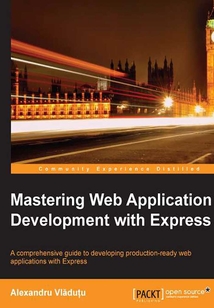- Index 更新時間:2021-08-05 17:54:37
- Summary
- Continuous Integration
- Client-side testing
- Load testing
- Code linting
- Complexity analysis of our code
- Code coverage
- Running tests before committing in Git
- Creating and testing an Express file-sharing application
- Testing toolbox
- The importance of having automated tests
- Chapter 11. Testing and Improving Code Quality
- Summary
- Reauthenticating the user for sensitive operations
- Session middleware parameters
- Handling file uploads
- HTTP security headers with Helmet
- Cross-site scripting
- Cross-site request forgery protection
- Running Express applications on privileged ports
- Chapter 10. Application Security
- Summary
- Removing debugging commands
- Adding a REPL to our Express application
- Debugging memory leaks
- Using the V8 debugger
- Debugging routes and middleware
- Using a debug flag
- A better error-handling middleware
- Chapter 9. Debugging
- Summary
- Ensuring the application uptime
- Useful existing monitoring tools
- Collecting metrics
- Simple tips for improving the application monitoring
- Logging
- Chapter 8. Monitoring Live Applications
- Summary
- Backend improvements
- Serving static resources with Express
- Chapter 7. Improving the Application's Performance
- Summary
- Error handling in a practical application
- Richer errors with VError
- Creating a custom Express error handler
- Logging errors
- Handling uncaught exceptions
- Improving stack traces
- Strings instead of errors as an antipattern
- Ways of delivering errors in the Node applications
- Runtime (operational) errors and human errors
- Chapter 6. Error Handling
- Summary
- A simple way to create custom errors
- Extending objects in a reusable way
- Ensuring a single callback execution
- Tiny modules for better control flow
- Error checks and callback functions
- Creating the MovieApp sample application
- Chapter 5. Reusable Patterns for a DRY Code Base
- Summary
- Choosing a template engine
- Integrating a template engine with Express
- View caching in production
- Template engine consolidation with consolidate.js
- DRY templates with layouts
- Sharing code between templates with partial views
- View helpers and application-level data
- The different types of template engines
- Chapter 4. Leveraging the Power of Template Engines
- Summary
- Content negotiation
- Facilitating caching
- Throttling
- API rate limiting
- API versioning
- Implementing the SmartNotes application
- Creating RESTful URLs of the application
- SmartNotes application requirements
- An overview of REST
- Chapter 3. Creating RESTful APIs
- Summary
- Replicating the middleware system
- Mounting subapplications
- Handling errors with middleware
- Ordering of middleware
- Express routes
- Environment-based loading of middleware
- Creating configurable middleware
- The functionality of middleware
- Connecting middleware
- Chapter 2. Component Modularity Using Middleware
- Summary
- The application structure
- Express into the wild
- Use cases
- Comparing Express with other frameworks
- The best parts of Express
- Chapter 1. Diving into Express
- Customer support
- Reader feedback
- Conventions
- Who this book is for
- What you need for this book
- What this book covers
- Preface
- Support files eBooks discount offers and more
- www.PacktPub.com
- About the Reviewers
- About the Author
- Credits
- 版權頁
- 封面
- 封面
- 版權頁
- Credits
- About the Author
- About the Reviewers
- www.PacktPub.com
- Support files eBooks discount offers and more
- Preface
- What this book covers
- What you need for this book
- Who this book is for
- Conventions
- Reader feedback
- Customer support
- Chapter 1. Diving into Express
- The best parts of Express
- Comparing Express with other frameworks
- Use cases
- Express into the wild
- The application structure
- Summary
- Chapter 2. Component Modularity Using Middleware
- Connecting middleware
- The functionality of middleware
- Creating configurable middleware
- Environment-based loading of middleware
- Express routes
- Ordering of middleware
- Handling errors with middleware
- Mounting subapplications
- Replicating the middleware system
- Summary
- Chapter 3. Creating RESTful APIs
- An overview of REST
- SmartNotes application requirements
- Creating RESTful URLs of the application
- Implementing the SmartNotes application
- API versioning
- API rate limiting
- Throttling
- Facilitating caching
- Content negotiation
- Summary
- Chapter 4. Leveraging the Power of Template Engines
- The different types of template engines
- View helpers and application-level data
- Sharing code between templates with partial views
- DRY templates with layouts
- Template engine consolidation with consolidate.js
- View caching in production
- Integrating a template engine with Express
- Choosing a template engine
- Summary
- Chapter 5. Reusable Patterns for a DRY Code Base
- Creating the MovieApp sample application
- Error checks and callback functions
- Tiny modules for better control flow
- Ensuring a single callback execution
- Extending objects in a reusable way
- A simple way to create custom errors
- Summary
- Chapter 6. Error Handling
- Runtime (operational) errors and human errors
- Ways of delivering errors in the Node applications
- Strings instead of errors as an antipattern
- Improving stack traces
- Handling uncaught exceptions
- Logging errors
- Creating a custom Express error handler
- Richer errors with VError
- Error handling in a practical application
- Summary
- Chapter 7. Improving the Application's Performance
- Serving static resources with Express
- Backend improvements
- Summary
- Chapter 8. Monitoring Live Applications
- Logging
- Simple tips for improving the application monitoring
- Collecting metrics
- Useful existing monitoring tools
- Ensuring the application uptime
- Summary
- Chapter 9. Debugging
- A better error-handling middleware
- Using a debug flag
- Debugging routes and middleware
- Using the V8 debugger
- Debugging memory leaks
- Adding a REPL to our Express application
- Removing debugging commands
- Summary
- Chapter 10. Application Security
- Running Express applications on privileged ports
- Cross-site request forgery protection
- Cross-site scripting
- HTTP security headers with Helmet
- Handling file uploads
- Session middleware parameters
- Reauthenticating the user for sensitive operations
- Summary
- Chapter 11. Testing and Improving Code Quality
- The importance of having automated tests
- Testing toolbox
- Creating and testing an Express file-sharing application
- Running tests before committing in Git
- Code coverage
- Complexity analysis of our code
- Code linting
- Load testing
- Client-side testing
- Continuous Integration
- Summary
- Index 更新時間:2021-08-05 17:54:37



